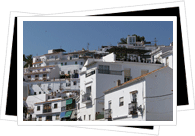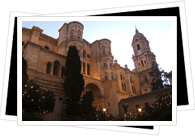 Malaga, having played host to a variety of vastly different civilizations lured in by its strategic sea-side situation, is blessed with architectural treasures and cultural traditions that bear witness to its rich history.
Malaga, having played host to a variety of vastly different civilizations lured in by its strategic sea-side situation, is blessed with architectural treasures and cultural traditions that bear witness to its rich history.
The honor of being the first inhabitants of Malaga is attributed to the Phoenicians. In the 8th century, B.C., they founded a settlement at the foot of the Guadalhorce River and called it “Malaka,” meaning “fish salting place.” Nearby, the Greeks also settled into the area and founded a colony which they called “Mainake.” However, this colony was later destroyed by the Carthaginians.
 In 218 B.C., the Romans drove out the Carthaginians and bestowed upon Malaga its status as a confederate city of Rome. Under Roman rule, Malaga enjoyed a growth spurt in the areas of commerce and architecture- the Roman amphitheater in the hills of the Alcazaba is just one of the standing proofs of the splendor enjoyed by Malaga under Rome.
In 218 B.C., the Romans drove out the Carthaginians and bestowed upon Malaga its status as a confederate city of Rome. Under Roman rule, Malaga enjoyed a growth spurt in the areas of commerce and architecture- the Roman amphitheater in the hills of the Alcazaba is just one of the standing proofs of the splendor enjoyed by Malaga under Rome.
The Arabs, Malaga’s next inhabiting civilization, invaded and included Malaga in their domain in 743 A.D. and their rule lasted for nearly eight centuries. Commercial activity in the area flourished and the population increased with the settlement of a variety of cultures– Berbers, Southern Arabs, Mozarabs, and Jews. With its seaport serving as a crucial point for commerce and barter, it was a prosperous time for Malaga. The Gibralfaro Castle, along with its surrounding walls and magnificent gates, serve as a remnant of this affluent period.
Attempts were made by the Christians to re-conquer the area and in 1487, the Catholic kings proved triumphant over the Moors. From then on, Malaga has remained in Spanish hands. Nevertheless, its religious communities continued to play an important role in its urban development.
This period was, however, a tragic time for Malaga. A series of poor harvests, epidemics, and floods brought devastation to its people. An earthquake also destroyed most of Malaga’s buildings- miraculously, the Cathedral of Malaga managed to survive.
The 16th century saw the redevelopment of Malaga. It was at this time when the Catholic Church had almost completed its system of parishes. By the 18th century, Malaga had become one of the most important commercial districts on Andalusia’s Mediterranean coast. Wine, sultanas, and silk were among its main exports. Then arose a high-class bourgeoisie composed mainly of two families, the Larios and the Heredias, both of whom contributed a great deal to the industrialization of Malaga.
However, the 19th century was a dark chapter for Malaga in which political and economic crises brought about a period of decline. The liberalist General Torrijos was ordered shot by King Ferdinand the Sixth in 1831, an event which served to represent the political instability at the time. A terrible plague also swept the region and Malaga’s sea trade with the Americas ceased, resulting in the collapse of its main industry.
It was only in the second half of the 20th century that this capital of Costa del Son once again experienced rapid urban and industrial growth as a result of the rise of tourism in the area. Today, Malaga is a modern city where you can still the encounter the vestiges of its past and whose rich heritage makes Malaga a must-see.